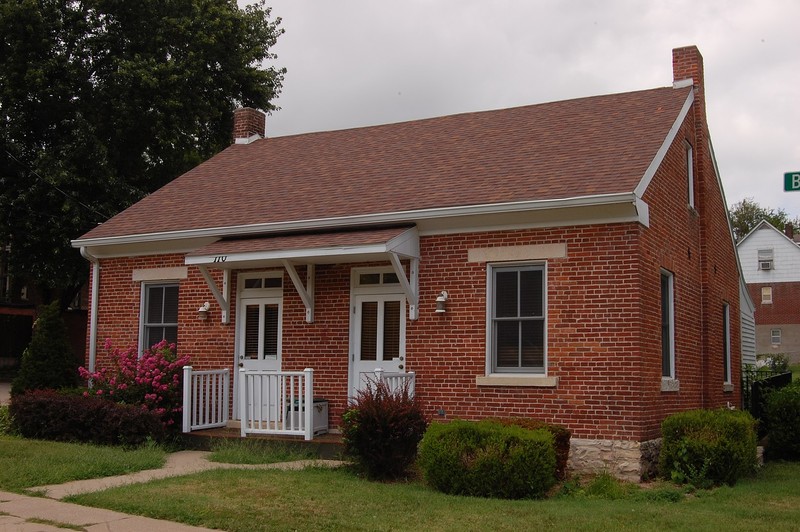Herman Haar House
Introduction
Text-to-speech Audio
The Herman Haar house, built in 1859 by Prussian native Herman Haar, is one of the few surviving antebellum Missouri-German dwellings in Jefferson City. In 1986, local citizens worked with city officials to preserve the home by moving it a short distance in order to save it from demolition during an urban renewal project. The German vernacular design, noted for its brick exterior, speaks to the abundance of German immigrants that settled in Jefferson City during the nineteenth century.
Images
Herman Haar House

Backstory and Context
Text-to-speech Audio
Missouri became a state in 1820, and the state legislature subsequently decided on Jefferson City (then Howard's Bluff) to serve as its state capital. The city's formal incorporation took place in 1825, and not long thereafter, German Immigrants began to migrate to the area. The first person to be naturalized in Cole county was a Prussian who became a citizen in 1834. However, the influx of German immigrants came during the 1840s and especially the 1850s, when political unrest and crop failures inspired many residents of German-speaking regions to leave Europe for North America. Nearly one million Germans immigrated to America during the 1850s, and many (roughly 90,000 by 1860) populated and settled on the Mississippi and Missouri Rivers.
Some of the earliest Missouri-German buildings in Jefferson City, including the Haar house, were built in the Capitol West area. As the name implies, that neighborhood is located west of the capitol building, on what was originally the western edge of the city. It was referred to as "mill bottom" in the early years because of the numerous flour mills in the neighborhood. The mills, along with the railroad, served as the area's primary employers, all close to the Haar House built in 1859, immediately preceding the Civil War.
The Haar House, like an abundance of homes built in Jefferson City during the nineteenth century, enjoyed German Vernacular architectural design and, more specifically, enjoyed the influence of Klassizismus, a German variant of the Neoclassical or Federal style. The German Vernacular style arose as a combination of German techniques and types with American and French influences. The chief element among the homes involves brick construction. Many German immigrants came from northern Germany, where brick construction was prevalent. And in contrast to rural U.S. areas where wood and stone were readily available and cheap, brick availability and cost made it popular among builders in urban communities. As such, brick kilns and brick sales emerged as one of the first industries in Missouri-German towns. Indeed, the first brick kiln arose in Jefferson City as early as 1826, and a large brickyard operated one block from the Haar house during the late nineteenth century.
Haar, who worked as a brick and stone mason, likely built the home rather than hire a contractor. It is unclear if he constructed the home to use as a residence or to sell; he bought and sold numerous parcels of land between 1849-1885. Nevertheless, Haar did sell the house in 1865 for a significant profit. By the time he sold the home, German-speaking residents had enjoyed profound influence in Jefferson City. In fact, German-speaking people comprised four of the six members of Jefferson City's first Board of Education in 1867 and made up nearly fifteen percent of Jefferson City's entire population by 1870.
Roughly seven million immigrants came to the U.S. from German-speaking regions of Europe during the nineteenth and early twentieth centuries. German-born people comprised nearly thirty percent of the nation's entire foreign-born populace during the last half of the nineteenth century. By 1890, about 125,000 Missourians were German-born, and approximately twice that number were German-speaking. It has been estimated nearly forty percent of Missouri's modern population has at least partial German ancestry, and structures such as the Herman Haar House offer reminders of the history dating back to the early- and mid-nineteenth-century.
Sources
Bergerson, Andrew Stuart and Thorsten Logge, eds. "German Migration to Missouri: A Transnational Student Research Project." 2019. https://www.geschichte.uni-hamburg.de/arbeitsbereiche/public-history/ebooks1/gmm-1-2019.pdf.
Burnett, Robyn and Ken Luebbering. German Settlement in Missouri: New Land, Old Ways. Columbia: University of Missouri Press, 1996.
Heritage Strategies: "Historic Preservation Plan." City of Jefferson, Missouri: Department of Planning and Protective Services. nps.gov. September 30, 2019. https://irma.nps.gov/DataStore/DownloadFile/646478.
Kamphoefner, Walter D. The Westfalians: From Germany to Missouri. Princeton: Princeton University Press, 1987.
Levine, Bruce. The Spirit of 1848: German Immigrants, Labor Conflict, and the Coming of the Civil War. Champaign: University of Illinois Press, 1992.
Orr, William J. "East Prussia and the Revolution of 1848." Central European History 13, no. 4 (1980): 303–31.
Sheals, Debbie. "Registration Form: Haar, Herman, House." National Register of Historic Places. mostateparks.com. 1997. https://mostateparks.com/sites/mostateparks/files/Haar%2C%20Herman%20House.pdf.
Sickels-Taves, Lauren B., and Philip D. Allsopp. “Making a Mark in America: The Architectural Ingenuity of Germanic Settlers.” Material Culture 37, no. 1 (2005): 85–106.
By Anneecox - Own work, CC BY-SA 3.0, https://commons.wikimedia.org/w/index.php?curid=34639132
